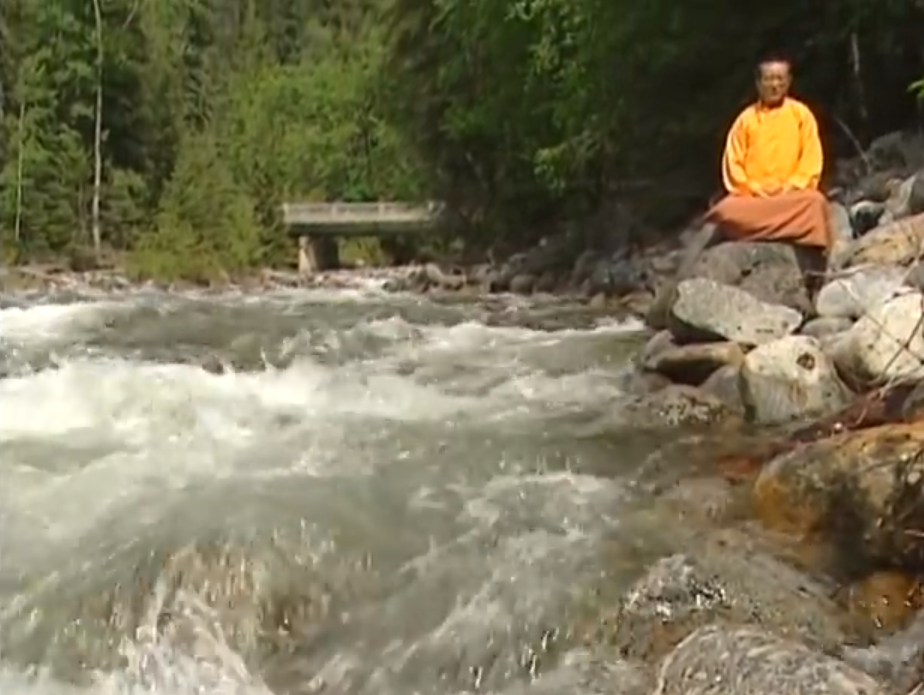Visualization Activates the Mind; Mindfulness Stills the Mind — Which is Right for Your Buddhist Practice?
The great Lama Yeshe said: “Our problem is that inside us there is a mind going, ‘Impossible, impossible, impossible. I can’t, I can’t, I can’t, I can’t’ … Human beings have great potential; they can do anything. The power of the mind is limitless.”
To subdue this “I can’t” mind, many Buddhists — and non-Buddhists — practice mindfulness to still the mind. In Buddhist practice, this stilling of the “monkey mind” has many advantages, and can help us glimpse reality as it truly is — the wisdom path to eventual enlightenment.

Then, to activate the “impossible” mind, Buddhists — and non-Buddhists — practice forms of visualization. Deity visualization in Vajrayana Buddhism is a powerful practice that imagines “ourselves as we would like to be, as an enlightened being, and this enables us to actualize that state much more quickly,” according to Geshe Tashi Tsering in his book Tantra: The Foundation of Buddhist Thought.[1]
Non-Buddhists also often enhance their life with personal visualizations — everything from daydreaming, to positive affirmations, to guided meditations. It’s the same principle in Vajrayana, except with Enlightened Beings as the object of visualization — and the mantra (and what that represents) as the positive affirmation.


Which is Better?
From a Buddhist point of view — neither. Mindfulness, or stilling the mind by bringing us intimately into the present moment, has an immediate advantage of simplicity in today’s busy world. It’s also easily understood, can be self-managed, and requires no major training. Visualization practice pursues the same goal with the opposing tactic: activation, rather than pacification, of the mind—using every sense in the body and every available neuron in the brain. Both styles of meditation have their own set of advantages and disadvantages. There are also separate “health” and living benefits, not related to practice goals.

At a high level, one of the goals of both styles of meditation, in Buddhist practice is to glimpse reality — and realize the wisdom of emptiness. More importantly, according to many teachers, mindfulness allows us to still our mind enough to glimpse our very own Buddha Nature—inherent to all sentient beings.
Deity visualization, on the other hand, allows us to step-by-step activate our Buddha Nature—rather than glimpse it. Using active, guided meditation, it also stimulates “compassion” in addition to “wisdom.” Bodhichitta is a major focus of nearly all visualization sadhanas (in modern speak, “manual” or guided meditation). By activating our “Buddha Nature” we overcome our sense of being “ordinary.”
“The sadhana is like a passport to a new universe,” writes Geshe Tsering. “At first glance it may seem like an arcane ritual, but when we understand the skillful way it can transform the mind, and especially how it uniquely blends the conventional aspects of our practice, such as developing the altruistic mind, with the wisdom realizing emptiness, we can see what a profound psychological tool it is.”
Mindfulness underpins Vipassana meditation methods—seeing things as they are. Deity visualization supports tantric methods — seeing beyond the ordinary.

“Through meditation on emptiness and bodhichitta, we use the visualization of arising as the enlightened deity to eliminate this sense of ordinariness,” explains Geshe Tsering in his masterful book on Tantra.[1] “The practice of generating ourselves as a deity and holding a sense of divine pride or divine identity is an integral part of Vajrayana practice. It is a way to bring the result into practice by feeling that we are already what we will one day be.”
What’s the Same?
All forms of Buddhist meditation share a single goal, no less than ultimate full Enlightenment. The methods differ, but there are at least four aspects that are the same:
- Goal: Enlightenment
- Goal: Bodhichitta (both aspiring and engaged Bodhichitta)
- Living the Six Perfections: generosity, patience, morality, joyous perseverance, concentration and wisdom.
- Wisdom realizing emptiness

Cutting the Ordinary
In addition to the shared traits, Vajrayana visualization cuts through “ordinary appearances” by using intense visualization and identification, and four unique elements, known as the four complete purities:
- Purity of Environment: accomplished through visualization of ideal sacred environment or mandala
- Purity of Body: through visualization of ourselves as an Enlightened deity
- Purity of Resources: visualizing mundane offerings as offerings suitable for the divine
- Purity of Activities: guided visualization on benefiting sentient beings.
Comparing the Two Skilled Methods
Mindfulness Deity Visualization
No focus Focus: Deity, or idealized Enlightened being.
Observe the self in the moment Observe what we one day will be/can be
Seeing beyond the ordinary Participating beyond the ordinary
Stills the mind Activates the mind
Stress-reducing Strongly enhances cognitive function
Easy to learn Normally requires a teacher
Self-guided Guided meditation
Non-focused Focused
Enhances wisdom Enhances wisdom and compassion equally
Simple and quick Complex and requires time commitment
Neurologically parasympathetic Activates sympathetic system
Immediate stress reduction Immediate cognitive enhancement
Observes energies and thoughts Manipulates energies and thoughts
Tends to pacify (relax) energies Deliberately activates subtle energies
Vajrayana visualization practice opens the mind in an active way. Vajayana and tantric Buddhists tend to practice both mindfulness and active visualization practices. Advanced practitioners may practice only deity practices, but these advanced sadhanas combine the best of both.

Visualizing Deities
The exotic nature of visualizing deities also shifts our mind, helping us move conceptually away from “ordinary” thinking. Deities in Buddhism are not Gods as thought of in theistic religions. Deities are a complicated topic, but from a strictly psychological point of view they tap into universal archetypes. “Each deity in Tibetan Vajrayana is an iconic representation of a particular enlightened energy within us that we are trying to actualize,” writes Geshe Tsering.
The very power of visualization is working with images (as well as sounds, smells, touch and other senses). For example, the image of compassion is Chenrezig (Avalokitesvara), is often visualized with 1000 arms, each arm reaching out to help sentient beings, symbolically expressing His extraordinary caring. Green Tara is visualized as green (symbolizing wind or activity), and she is seen with one leg outstretched — the hero leaping up to help those in need, in Her lovely capacity as a savior.
Since visualizing requires an object of refuge to visualize, deities are reinforcement for our meditation. We tap into an particular aspect of the Buddha Within—for example Manjusri for “wisdom” or Avalokitesvara for “compassion.” The power of sadhanas stems not only from the combination of wisdom and compassion, but also from the use of all the senses to reinforce the “beyond ordinary” experience.

All the Senses Used in Sadhanas
We use multiple skilled methods and all the senses in visualization practice, reinforcing the extraordinary meditational experience, for example:
- sound: words and mantras
- breath: visualizing prana (chi) and the subtle body
- smell: we visualize the scent of wonderful offerings of incense
- taste: we visualize food offerings
- prayers: in psychological terms, affirmations
- offerings: representing our generosity and generating merit
- activity: for example, visualizing purifying light blessing all sentient beings, and other activities.
All of this reinforces the visual symbolism of the deity. Sometimes, even the actual physical (or visualized) location is heavy with symbolism and reinforces our meditational goals. For example, advanced Chod practice is often conducted in a Cemetery, at night.

In The Way of the White Clouds, by Lama Govinda, he describes deities as “not merely beautiful decorations of aesthetic value but as representations of a higher reality, born from visions of inner experience. They were put into as precise a language of forms as is contained in a geographical map or scientific formula, while being as natural and expression as direct an appeal as a flower or a sunset.”
Non-Buddhist Scientific View
From a less spiritual point of view, mindfulness is well accepted in the psychiatric community as a method for reducing stress, and improving health issues that are impacted by stress — arguably all major health issues. A 2011 study in Neuroimage, broadly maps out how mindfulness changes the brain for the better.

On the other hand, Vajrayana Deity visualization practices improve cognitive performance and have a promising impact on patients with degenerate brain disorders, according to a study from the National University of Singapore.
Difference in Perspective
What’s the main difference between non-Buddhist and Buddhist perspectives on the two methods? The goals, clearly. Buddhist practitioners will have taken refuge prior to any meditation, while non-Buddhists likely wouldn’t. As Buddhists, the ultimate goal is nothing less than touching the Buddha within and achieving Enlightenment. Non-Buddhists will be content with either heightened relaxation and stress relief—with mindfulness methods; or, improved cognitive function, conceptual thinking and planning with active guided visualizations.
Which is better? Neither. Both are powerful, and most people can benefit from using both styles of meditation. Mindfulness meditation pacifies, creating space for wisdom—and reducing stress. Visualization, on the other hand, activates mind on the heroic quest for the Buddha Within—and improves cognitive function. Contrary to the notion that they might be opposites—pacification versus activation—they are complimentary.
Some of the images in this article feature Zasep Tulku Rinpoche from the movie Please Come Again:
NOTES
[1] Tantra: The Foundation of Buddhist Thought, Volume 6, Geshe Tashi Tsering foreword by Lama Zopa Rinpoche.
[2] Visualizing Yourself as a Deity, Lama Yeshe Wisdom Archive
More articles by this author

Who is my Enlightened Life Protector Based on Tibetan Animal Sign Zodiac in Buddhism? According to Mewa, Mahayana tradition and Kalachakra-based astrology (with Mantra Videos!)
Search
Latest Features
Please support the "Spread the Dharma" mission as one of our heroic Dharma Supporting Members, or with a one-time donation.
Please Help Support the “Spread the Dharma” Mission!

Be a part of the noble mission as a supporting member or a patron, or a volunteer contributor of content.
The power of Dharma to help sentient beings, in part, lies in ensuring access to Buddha’s precious Dharma — the mission of Buddha Weekly. We can’t do it without you!
A non-profit association since 2007, Buddha Weekly published many feature articles, videos, and, podcasts. Please consider supporting the mission to preserve and “Spread the Dharma." Your support as either a patron or a supporting member helps defray the high costs of producing quality Dharma content. Thank you! Learn more here, or become one of our super karma heroes on Patreon.
Lee Kane
Author | Buddha Weekly
Lee Kane is the editor of Buddha Weekly, since 2007. His main focuses as a writer are mindfulness techniques, meditation, Dharma and Sutra commentaries, Buddhist practices, international perspectives and traditions, Vajrayana, Mahayana, Zen. He also covers various events.
Lee also contributes as a writer to various other online magazines and blogs.

















